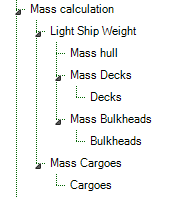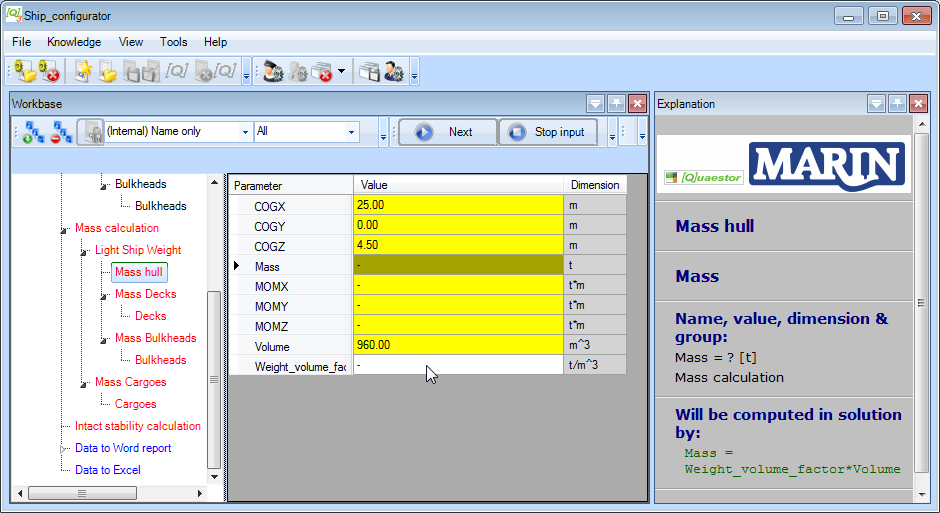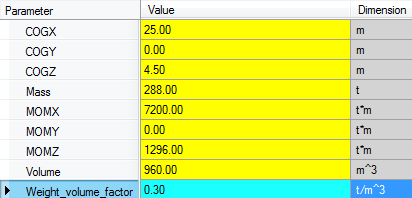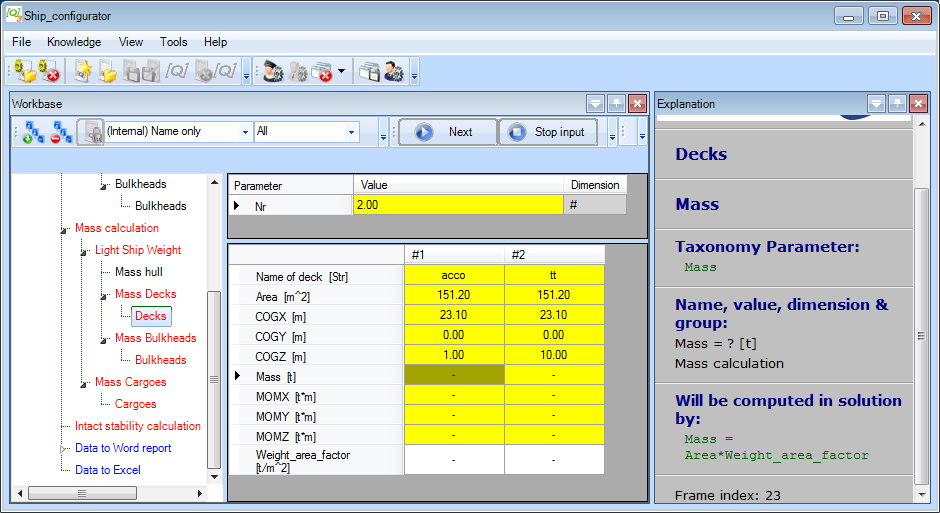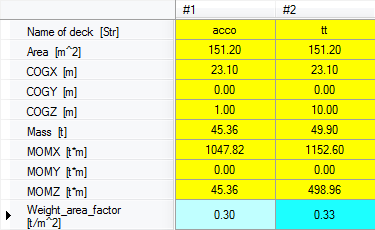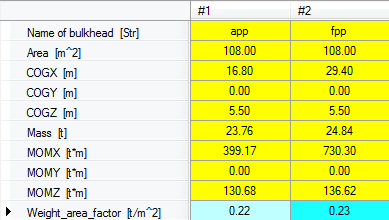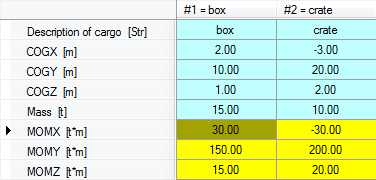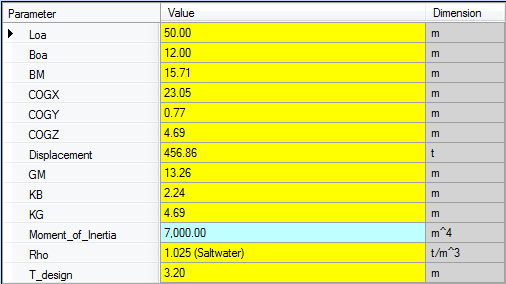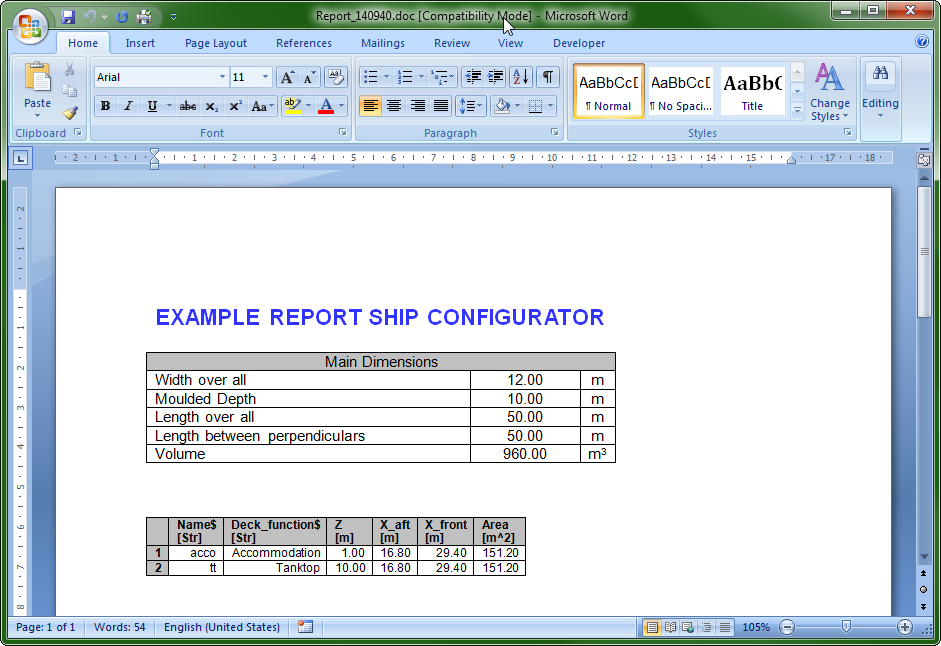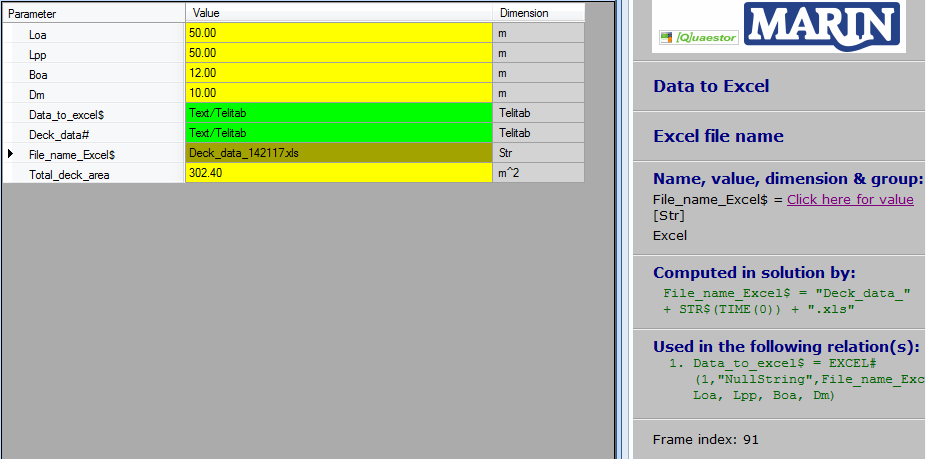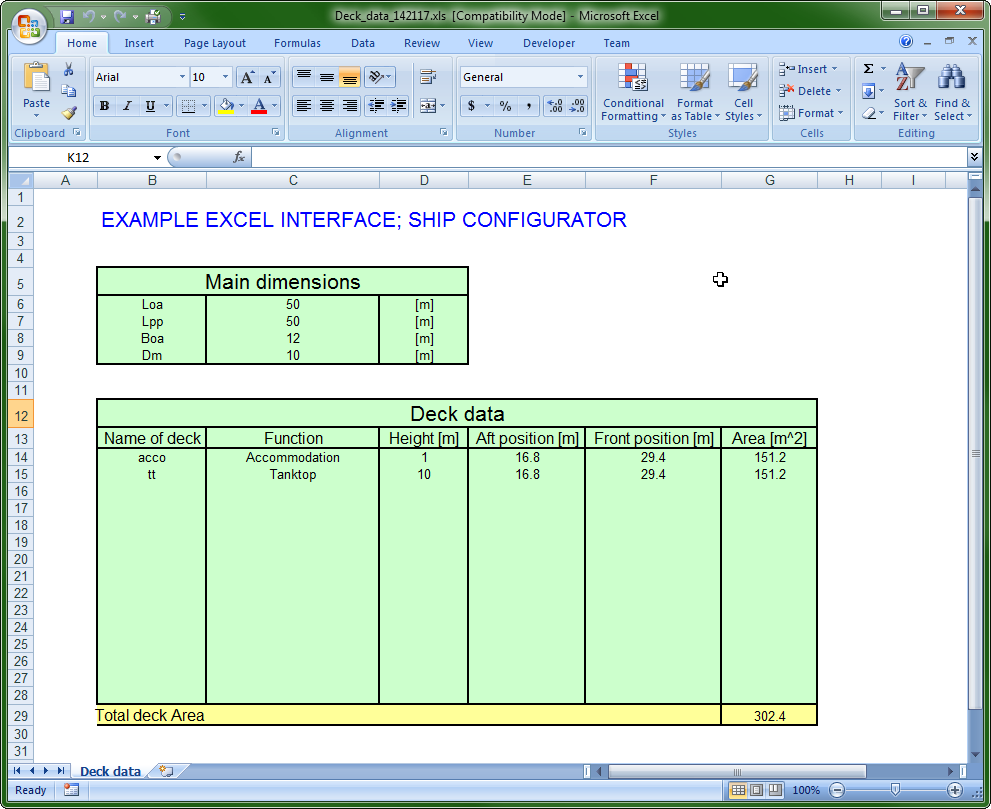Page History
1 Mass calculation
If Now that the ship lay out is finalized (it is always possible to change values afterwards) , the first analysis, Mass calculation, can be performed. Incidentally, it is always possible to change the values you entered in the previous section. The child entities of Mass calculation are:
In the Mass Calculation entity, which is a subgoal of the total solution, . Figure 23 presents Entities below Entity “Mass calculation”. In here the mass and the centre of gravity of the whole system will be calculated, which depends on the mass and centre of gravity of both light ship weight and weight of cargo objects. These quantities depend on the mass and centre of gravity of both the ship itself (Light Ship Weight) and the cargo it carries (Mass Cargoes). The total mass is calculated by the summation of all mass components. The centre of gravity of a system of components is defined as the average of their positions, weighted by their masses. This method is used at every level within the (entity/subgoal) of Mass calculation.
Figure 23: Tree view mass calculation
In the entities Mass Calculation and Light Ship Weight (and Mass Cargoes) no input is requested from the user.The first 'stop' in the calculation process is in Mass hull.
- If you have not done so already in the previous part of this tutorial, click Next. In any case, the screen should now look like this:
Quaestor will calculate all information in these entities At the level of Entities “Mass Calculation”, “Light ship Weight” and “Mass Cargoes” no input is requested to the user. So click “Accept input & Continue”. Quaestor calculates all information in these Entities when all required information from lower Entities entities is available. 4.11 Provide input values for Entity Mass HullYou can see this because these entities are still colored red. A yellow cell will be calculated by a relation.
Based on the results of Entities “Main Dimensions” and “Hydrostatics” below Entity “Hull” the entities Main Dimensions and Hydrostatics (in Ship design | Lay out | Hull), the centre of gravity and volume of the hull is determined. Scroll through the parameter list to see the used relations in the Explanation window. For this simplified ship configurator we assume it is assumed that the mass of the hull can be computed by:
Mass = Weight_volume_factor * Volume
As a user, you only have to have to provide a weight volume factor, for example 0.5 [t/m3], see Figure 24. The moments around the X, Y and Z axis are determined by Mass multiplied by respectively COGX, COGY and COGZ.
Figure 24: Example input Entity "Mass hull"
4.12 Mass calculation of Decks and Bulkheads
- Enter 0.3 [t/m3] as the value of
Weight_volume_factorand press Enter.
Quaestor calculates everything it can upto now and fills in all values in the list:
- Click Next to continue the calculation of the next subgoal (entity).
In the previous section, you In section 4.8 you already defined the names and positions for a number of decks; in this tutorial two decks were defined. Entity “Decks”, below Entity “Mass Decks”, The entity Decks presents a table , containing which contains a number of parameters for each defined Deck; the deck name, the (deck) area and the centre of gravity, see Figure 25.
Figure 25: Provide weight factor for every deck you have defined
Again, a yellow cell means that a value is a top Goal for the analysis and it will be determined by relationsa relation. The parameters “Nr”, “Name of deck”, and “Area”, are automatically copied from the defined “Deck” Entities entities below Entity “Lay out”. When you add or remove a deck, or change properties of an existing defined deck, these adaptations will be automatically propagated to the “the Mass Decks” Entity entity.
The centre of gravity of a deck is based on the given location in your ship design. For this simplified ship configurator we assume , it is assumed that the mass of the decks can be computed by:
Mass = Weight_area_factor * Area
As a user, you only have to provide a weight area factor for each deck, for example 0.02 . The mass calculation as applied for decks is also used for the mass calculation of bulkheads.
- Enter the values 0.30 [t/m2] and 0.
...
- 33 [t/m2]
...
- for the
Weight_area_factors of the decks and press Enter.
- Click Next and enter the values 0.22 [t/m2] and 0.23 [t/m2] for the
Weight_area_factors of the bulkheads and press Enter.
The last thing to do for the mass calculation is entering data for the cargo objects. You'll know how to do this. For this tutorial, limit yourself to a few objects, because otherwise you will have a lot to enter! Note that there is a picture of the coordinate system to help you in the Explanation window. For two pieces of cargo, the input will look something like this:
2
Figure 26: Example input values Entity "Bulkhead" below Entity "Mass Bulkheads"
4.13 Define number of cargo objects
Besides the light ship weight calculation it is possible to define the name, COG and mass of a number of cargo objects. Further explanation is not needed. Example input values are given in Figure 27. Please note a schematic picture in the Explanation window depicts the vessel coordinate system as support for the user.
Figure 27: Example input values Entity "Cargoes"
...
Intact stability calculation
The mass and centre of gravity of the whole system are input for the intact stability calculation. For this tutorial a very unrealistic simplified stability |Co calculation is developed. The moment of area inertia of the waterline water plane area is the only required input value.
Entity “The entity Intact stability” is only included to give an idea how a configurator can be build built with a taxonomy approach. Example input values for Entity “the entity Intact stability” is presented in Figure 28.
Figure 28: Intact stability calculation
...
are presented below:
3 Data to Word report
At the moment you leave Entity “the entity Intact stability” with the "Accept input & Continue" button Next button, Quaestor jumps automatically in Entity“Data to the entity Data to Word report”report. In here Here you do not have to provide any input values. Quaestor will directly generate (if all information from the previous Entities entities is available) a little MS Word report. When you have this document open at that moment, you will see the generation of the reports taking place on your screen.Please be
| Note |
|---|
Be aware that fatal errors may occur when you are actively working in Word while the reports are generated. Therefore, please wait until the documents are closed. |
There are two ways to open the created Word documented from inside Quaestor.
- Select the parameter
Report_document$in Entity “Example report” and click the entityExample reportand click on “Click here for value” in ” in the Explanation window below “Name, value dimension & dimension”group”. - Double click on the report name behind the click on the value of parameter
Report_document$(in Figure 29 “Report_151212_2.doc”).
FinallyOf course, it is always possible to find and open the document in your project folder on your computer. The example report document is built up from two sub documents (two chapters) that also can be watched / opened separately.
Figure 29: Generation of example MS Word report
...
4 Data to Excel
The main dimensions and a table of deck data will also be will be written to an Excel file too. In here Here, the total deck area will be calculated and the result will be send back to Quaestor in parameter “Total_deck_area”, see Figure 30area. If Quaestor knows all the required data, the Excel file will be made at the moment you are in Entity “Data to Excel”.Please note that the visit the entity Data to Excel.
| Info |
|---|
The knowledge engineer (the developer) can decide whether to leave |
...
an Excel sheet (or |
...
Word document) open, or close it automatically. In the case of the Excel sheet, it |
...
was decided to leave the Excel sheet open. |
There are two ways to open an Excel file from Quaestor.
- Select the parameter
File_name_Excel$in Entity “Data to Excel” and click the entityData to Exceland click on “Click here for value” in ” in the Explanation window below “Name, value dimension & dimension”group”. - Double click on the Excel file name behind the parameter click on the value of parameter
File_name_Excel$
Of course Finally it is always possible to find and open the document in your project folder on your computer .
Figure 30: Data to Excel(The default path for the Ship_configurator is C:/Users/Public/Documents/My_Knowledge/Projects/_Ship_configurator/Solutions).
| Info |
|---|
If you are a Knowledge Engineer, you might want to continue with the tutorial explaining how the database that was used here can be developed. |
...
